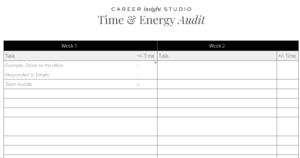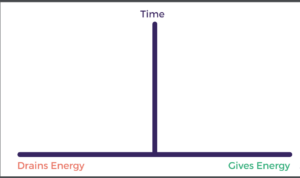This simple reflection exercise can help you to be more intentional about what lights you up at work and how to make more time for the things that matter.

The first professional coach I hired came into the picture when my job began to feel unmanageable. At the time, I was buried under a mountain of tasks, desperately trying to find extra time amidst endless meetings and deadlines. Sound familiar? It’s surprisingly easy to fall into the routine of automatically accepting more responsibilities—much like the proverbial frog in the pot, staying put in a slowly boiling situation may result in getting cooked!
While it’s not always possible to simply say “no” to new assignments, recognizing when your job has stretched beyond its original scope is crucial. That’s where a Time & Energy Audit comes in handy. It’s a simple way to evaluate how you spend your time and give you a chance to take a step back, assess, and hopefully recalibrate your work life for greater satisfaction. The coach I worked with used a similar approach but called it a “Love it/Loathe it” exercise.
“We can always make more money, but we can never make more time”— Jim Rohn, American entrepreneur, author, and motivational speaker.
What is a Time and Energy Audit?
Dan Martell, the author of great book for entrepreneurs called Buy Back Your Time, drives this point home…how you use your time will make or break your success. The secret? It’s not about grinding harder or finding more time to do work. It’s about the systems and mindset shifts necessary to engage in the high-value work that brings you energy, fulfillment and impact to your job. He provides a specific formula to calculate the value of your time and buy back free space on your calendar. Even though his book is tailored to founders and business owners, the principle of a Time and Energy Audit is very relevant to all who work. It’s a simple exercise that allows you to identify the “energy-giving” and “energy-draining” activities that occur throughout your workday.
The result of doing an audit is a list of insightful data designed to help you understand where you time is spent and how it makes you feel. With that perspective, you can move away from “autopilot” mode and toward a more intentional workday—which is good for everyone!
How to Conduct a Time and Energy Audit
It’s easy and free to do the audit! You simply need a piece of paper or a blank spreadsheet. I created an editable template, which you can download here.
If you prefer to use an app, Toggl and RescueTime are also good options to consider.
Step 1: Define Your Goals
First, determine what you want to achieve with this audit. Are you looking to reduce stress, increase productivity, or find more time for personal interests? Being intentional about your motivation will give you the most impactful data.
Step 2: Track Your Time
Grab your paper or spreadsheet. For one week, keep a detailed record of how you spend your time. Document every activity – no matter how small – and the time you start and end each activity. I know this sounds a bit over the top, but trust me, this is critical information and the basis for the audit.
Step 3: Monitor Your Energy Levels
As you jot them down, pay attention to how you feel during different tasks. Alongside each logged activity, note your energy level on a scale from very low to very high. This helps to identify which activities drain or energize you. You can do a + or — sign, or color code with red and green. Whatever makes the most sense to you is fine. When I did this exercise, I noticed I was more energized by meeting people 1:1 and working on process improvements vs reviewing 20 page contracts or submitting expense reports 😉
Step 4: Analyze the Data and Plan for Change

After a week, grab a nice cup of coffee and clear some time to review your logs. Now, look for tasks that consistently drain your energy and those that boost it. Do you see any patterns emerging? Ask yourself questions like:
- What is the ratio of energy draining vs. energy boosting tasks in my week?
- What am I spending the most time on?
- Are the energy-boosting activities woven in evenly to provide relief, or all batched on one day or time block?
- Are there ways to delegate or minimize time spent on tasks that drain my energy?
- Are the draining tasks something better suited for someone else who would enjoy doing it — either as a learning opportunity or is an area of strength?
Now that you have identified the tasks that make you happier and more energized, consider ways to integrate those more consistently into your workday.
Step 5: Implement and Review
Now it’s time to implement changes based on your audit findings. Start with small adjustments to ensure they are sustainable.
Repeat the audit periodically. This helps to refine your approach and adapt to any changes in your work or personal life.
Step 6: Reflect on Changes
Regularly assess how the changes have affected your productivity and satisfaction. Adjust as necessary to optimize both.
By regularly performing a time and energy audit, you can make more informed decisions about how to use your time effectively, leading to greater overall work satisfaction and happiness. I hope you find it useful!
Thank you for reading.

Additional Resources:
- The Time and Energy Audit concept is from Buy Back Your Time by Dan Martell.
- Another audit approach is to do the “Love it / Loathe it” exercise.
- Ted Talk on “Job Crafting” –The Power of Personalizing our Work.
- Check out the Ideal Week Method for more ideas on work balance.


